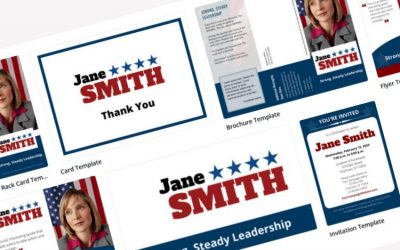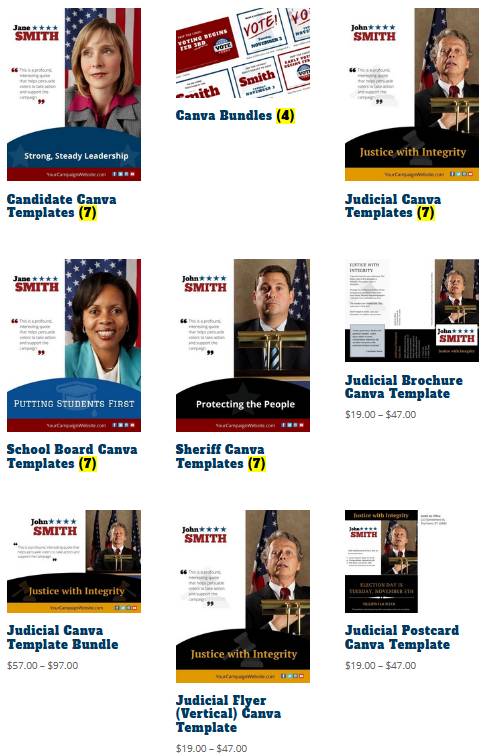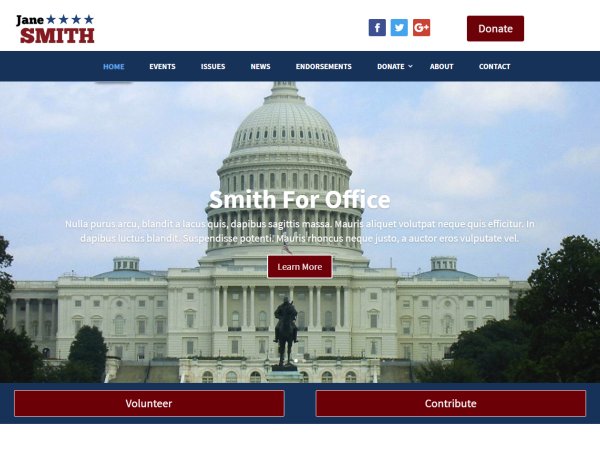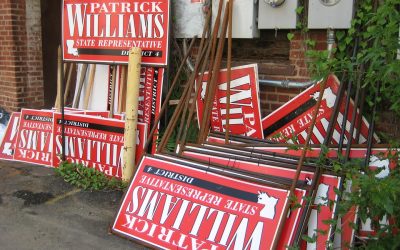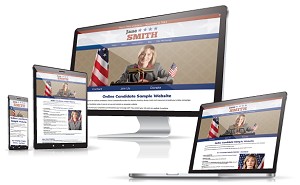Tips for Creating a Great Campaign Brochure
When putting together your campaign brochures, you want to put your best foot forward. Your brochure may be the first, last, and only time you will reach a voter. Here are tips to creating an effective election brochure that will make a good impression on your target voter.
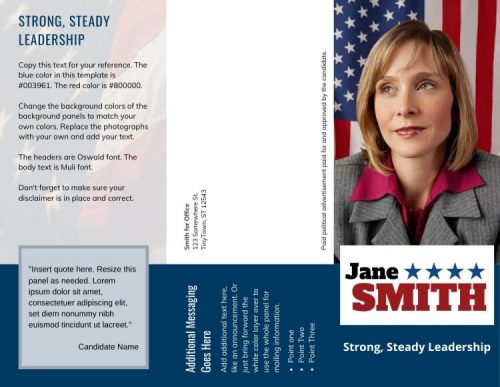 Sample Brochure Layout – Click For More Political Brochure Design Examples
Sample Brochure Layout – Click For More Political Brochure Design Examples
Write out your content, while keeping in mind the amount of space you have to work with. Odds are you will start with way too much text, and you’ll need to cull down the material.
That’s fine, because you’ll want your copy to be as lean and to-the-point as possible.
Keep in mind the overall design and layout of the brochure or political pamphlet. For example, if your piece is tri-fold brochure mailer, two-thirds of one side will be for address information and the ‘cover’ on the other side.
In the brochure copy itself, try to:
- Keep to one idea per paragraph.
- Use short sentences.
- Use bullet points where possible to free up as much white space as possible.
- Use headers and divide the text into sections (About the Candidate, Issues, Voting Information/Election Date…)
- Include a call to action. This is usually a reminder to vote on Election Day or perhaps a statement about the candidate or the opposition.
- These guidelines apply for both candidate and political party pamphlets, election leaflets, campaign handouts and flyers.
What makes a good brochure design?
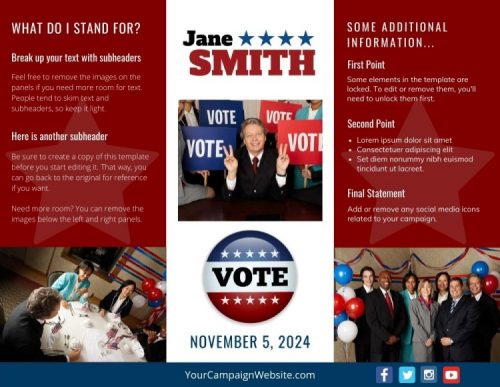 When designing political campaign brochures, keep the layout simple. Be sure the main colors of the brochure match your other campaign materials, yard signs, and website. Script fonts should be generally avoided for readablity. Keep in mind that using more colors adds to the cost of printing.
When designing political campaign brochures, keep the layout simple. Be sure the main colors of the brochure match your other campaign materials, yard signs, and website. Script fonts should be generally avoided for readablity. Keep in mind that using more colors adds to the cost of printing.
Make sure the front panel is attention-getting
The front of your leaflet should communicate your main point clearly and succinctly. If it doesn’t, your carefully-crafted literature may end up the recycling bin, unread. You may want to use a question or powerful statement on the front of the piece to draw attention.
Photographs provide powerful visual elements
Political brochures should include at least one photo of the candidate. Typically, a professionally-shot candidate photo should appear on the cover, along with an ‘action shot’ inside. All the photos should make the candidate look good with proper dress and backgrounds. The last thing you want potential voters to do is to scrutinize the candidate’s fashion sense or the corporate logo of some item in the shot’s background.
A picture can tell a thousand words; charts and graphs can do the same
Your graphics should be simple in design and clearly illustrate a point. A simple explanation under the chart should be all you need to make your point. Images for the sake of taking up space only serve to distract from your piece.
As your election pamphlet design is finalized, it’s likely that you (or the designer) will need to adjust the different elements to make everything fit and flow properly. If there is too much text, the font size may need to be adjusted or the graphics or photos re-sized. You may need to further condense your copy.
A cramped brochure looks bad and is less likely to be read.
Put together your content
You have limited space to place your content. The purpose of your brochure will determine what, exactly, the content will contain. Writing an introductory piece to voters is different than a get out the vote or an opposition attack piece.
If the piece is to convince voters why you should be elected, you should spell it out for them.
- List your experience and offices you previously held as a candidate.
- Briefly include your accomplishments and activities.
- Keep your message short and to the point.
- Balance out the copy with additional testimonials or endorsements.
If you are writing about a particular issue, keep your points bulleted and short. You may want to include relevant quotes from others who have a stake in the issue or legislation.
Include additional campaign information.
- Your campaign website
- Contact information
- Email address
- Social media channels
Remember, you have limited space. Don’t stuff too much text. Plenty of space in your layout helps makes your brochure easier to read.
Finally, proofread the brochure for misspellings or grammatical errors
Have a few people review the piece for readability. Preferably, they should be people who were not involved in creating the print piece. That way they have an objective point of view.
Tip: From professional experience we’ve found that it’s better to limit the number of people involved in writing and editing the brochure. Campaign material created by committee tends to be unfocused, as the brochure, flyer or pamphlet ends up trying to cover too many points in a single piece.
Canva political template examples from our download store.
We have versions for local candidates, school board candidates, judges and sheriffs.
Printing your campaign brochures
If you are having an outside company print your brochures or pamphlets, check their printing requirements and be sure to provide everything they need. They may need a particular format and image resolution. Images and design elements should beat least 300 dpi.
Tip: Web images are 72 dpi, so don’t use graphic elements from your website in a print piece.
The post office can inform you about requirements that must be met for mailing brochures. For example, are there are specific size or bulk mail requirements? The USPS considers election mail as any item mailed to or from authorized election officials or organizations.
Finally, upload a digital version of the election brochure to your campaign website so that it is available for others to download, share and print. Don’t forget to add it to your online press kit.
Bonus Tip: If you are looking for campaign literature examples, look no further than your mailbox. Create a political swipe file and save the good brochures, mailers and pamphlets sent by other candidates as examples for inspiration.
Free up your valuable time! Our easy-to-customize Canva Political Templates will add a professional edge to your campaign brochures and handouts. Online Candidate website clients have access to FREE editable social media graphics.
WordPress Political Website Templates
Online Candidate now offers WordPress political website templates for download by customers who are not Online Candidate® clients.
These themes are designed for candidates or political parties with the resources to build their own websites but who want a good design starting point. They are also useful for campaigns or organizations that already have web hosting or are looking to update their site design.
The templates are Divi child themes for WordPress, designed to be easily edited and customized. You can also add plugins for additional functionality.
All these themes are sold through our companion site, OnlineCandidateWP.com.
Please note that the templates below are NOT part of our Online Candidate political website platform. They do NOT include site hosting or any built-in Online Candidate tools or resources. We do not offer additional design or hosting services for these products.
Our political website template features include:
- 10 full page layouts – including pre-built home, events, issues, endorsements, donate, about and contact pages.
- Editable global header and footer sections, along with main menu options.
- Email signup, volunteer and endorsement forms included.
- 404, search results, and category archive templates.
- Stock images images included, suitable for personal and commercial use.
- Library of design elements to edit and reuse across pages.
- Fully responsive design so you site looks good on all devices, desktop and mobile.
We offer several layouts for different elected positions. They are designed to help save development time and costs. You are free to edit the designs in any way you choose.
Political Candidate WordPress Template
Cleanly designed and fully responsive, this Divi child theme is specifically designed for political campaigns. It can serve a number of purposes, such as for an important election, a candidate’s personal website, or a website for a political party. The default design color scheme is red, white, and blue, but you can change those colors if you choose.
Get started with your political website easily with a great template designed by professional designers. They are suitable for all types of offices, from local, state, to federal positions. Everything from city council, to mayor, supervisor and even representative and senate races.
All content from the site demo is included, including built-in forms and the page layout. Little to no extra page development is needed. Every page in the demo has a corresponding template. Divi sections are saved to the library to make page updates simple.
Judicial Website Theme
Clean design and fully responsive, this Divi child theme is specifically designed for judicial elections and campaigns for judges. All of the site content that appears in the demo is included. Little to no additional page development is needed. Swap out demo text and images and configure the settings to your liking. This gives you control over the design and appearance of your site. It’s also suitable for use for attorneys and law firm websites.
View Judicial Wordpress Website Template
Sheriff Website
Fully responsive with a clean black and white layout, this template is specifically designed for sheriff and law enforcement campaigns. As with our other WP themes, all demo content is included with installation. Little to no extra page development is needed. You are free to swap out demo material and configure the site settings and images to your liking.
View Sheriff Wordpress Template
School Board Election Theme
Blue and red, this layout is specifically designed for school board elections or can be used for actual school websites. All content, images and forms are included. School board candidates have the opportunity to fill their issue pages with information that can help them build support and win their election.
View School Board Website Template
All of these political website templates are designed to help free up time and resources for candidates and political organizations. With the included pages, navigation, built-in forms and content layout, most of the design work has already been done for you!
Full step-by-step instructions are included so you can get a fresh WordPress installation looking like the site Demos in about 15 minutes.
Again, these templates are Divi child themes. You need to have an installation of the paid Divi theme for them to work.
Divi, one of the most popular WordPress themes, is a drag and drop page builder that makes designing your site easy. It comes with 40+ pre-made layouts which you can quickly adjust to suit your needs. Want to go beyond the included layouts? Use the intuitive Divi Builder, which includes features like full-width rows, custom headers & footers, multiple blog layouts and more.
If you are looking for a simple-to-use alternative to WordPress? Consider using the Online Candidate website platform.
Get the Most From Your Campaign Yard Signs
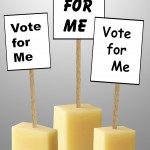 Campaign yard signs are typically the first form of advertisement voters see from a political campaign. Having a successful sign placement strategy is vital to make sure the money spent on signs has a substantial impact on the voters.
Campaign yard signs are typically the first form of advertisement voters see from a political campaign. Having a successful sign placement strategy is vital to make sure the money spent on signs has a substantial impact on the voters.
Name recognition is a high priority for candidates and political lawn signs are very effective if used properly.
Use voting area maps to determine sign placement
Acquire a map of the voting area. Useful maps are typically available from government planning and printing offices. Often, the maps can be downloaded off the internet from government websites. These maps are useful in determining important road intersections and busy traffic locations where campaign yard signs should be placed.
Most state and county transportation departments provide maps and data indicating the average daily traffic numbers in the area. Mapping software is also available which provides census statistics plotted on political districts. The software makes it easier to locate the important voter blocs.
Follow the rules in using campaign signs
Cities and counties have their own rules regarding signs, including the placement of them. Make sure everyone involved with the campaign yard signs is aware of the rules.
For example, most areas require that election lawn signs be placed at least ten feet from the road. Also, some homeowner’s associations have rules and limitations concerning political signs.
Finding good locations for your signs
An effective initial strategy is to contact your political party, retired politicians and candidates from the same political party who are campaigning in the district and ask them for names of supporters who allow political lawn signs on their property.
High traffic areas are obvious locations for campaign yard signs. It provides a lot of visibility to those who pass by. Intersections are also good because signs are noticed by stopped motorists.
There may be specific private properties that have high visibility. Have volunteers call those property owners and ask for permission to place a sign on their property.
Reducing visual blindness
After a while, voters driving by the same signs at the same locations tend to not pay attention to the campaign lawn signs. Campaigns can shake things up by exchanging a large sign at a location for an existing small sign. Adding more signs to the location can also grab the attention of voters.
Another useful strategy is to place some of your bigger election signs next to your competitor’s small signs. It has the effect of making the candidate with the big sign look more powerful and important.
Placing a vast number of election lawn signs in the candidate’s voting area is an effective strategy for increasing name recognition, however if too many signs are crammed in a specific area, voters can become annoyed by the bombardment of signs, and it can have a negative affect on them.
Even in these days of high technology, campaign yard signs are an effective way of increasing name recognition and improving the chances of winning the election.
For more information on campaign signs and custom yard signs, visit CampaignPros.com.
Looking for professional logo templates for your signage? Check out our selection.
Local Campaign Letters to the Editor
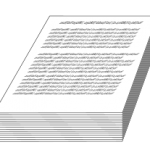 When it comes down to it, letters to the local newspaper editor is a form of campaign advertising. Of course, the letters are the opinions of the writers, but they typically represent honest views and bring up points or subject matter not covered in the usual political campaign ads.
When it comes down to it, letters to the local newspaper editor is a form of campaign advertising. Of course, the letters are the opinions of the writers, but they typically represent honest views and bring up points or subject matter not covered in the usual political campaign ads.
Of course, in this digital age, ‘letters’ can also mean e-mails. Many newspapers allow letters to the editor to be sent electronically. For the purposes of this article, we are referring more to physical letters, but the same principles apply to both forms.
Like most aspects of your campaign, letters to the editor can be a coordinated effort. It’s one facet of an advertising campaign that can help grow support for a candidate and promote the campaign message. A well-written letter can influence a voter. A number of well-written letters published week after week can influence a LOT of voters.
Encourage your supporters to write letters to the editor. Tell them that they can help by writing and sending to local newspapers a positive message about the candidate and the issues. You really never know what people will say. Some letters will be pro-candidate, others will talk down an opponent. A few won’t make much sense at all. Some of the best letters will come from voters who are not affiliate with any party or organization, but simply want to express an opinion.
For close supporters, you can provide them with specific issues or ideas that would be particularly helpful to the campaign. Close supporters should still write their own letters in their own words. It may be helpful to have these letters written early and collected so that they can be mailed to the newspapers on a schedule, starting weeks or even months before the election day.
Using a standard format for structuring a letter is fine, but letters should NOT be pre-written for people to simply sign. When a bunch of letters are published that all have the same talking points and the same phrasings within them, it’s propaganda. Readers can usually see though propaganda, and most won’t like it.
Finally, don’t wait until the last days before the election to have supporters send in letters. Newspapers get flooded with campaign letters to the editor and will probably not publish them all. Letters that are sent in the weeks prior to election have a better chance of being published.
Save time and effort with Online Candidate Letter Templates, which includes letter to the editor templates, campaign press releases, fundraising and volunteer letter templates and more!
DIY Homemade Political Yard Signs
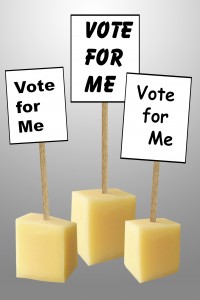 Homemade political signs can be useful for small to medium-sized campaigns. They are often used to supplement tradition printed yard signs. Making them requires little more than some materials, paint, stencils and time.
Homemade political signs can be useful for small to medium-sized campaigns. They are often used to supplement tradition printed yard signs. Making them requires little more than some materials, paint, stencils and time.
Most campaigns purchase the bulk of their yard signs. However, local campaigns with a limited budget may not have funds for purchasing a large number of signs.
Most signs created as DIY efforts are done in limited numbers. It’s difficult, but not impossible to mass produce your own yard signs. With some cardboard, a stencil and spray paint, you can make your own campaign signs. For your sign stakes, you can either make or purchase them.
Elements of a DIY political sign
All signage have common elements that you want to include:
- Logo: You may or may not have a logo. If you can add a copy of the logo, do so. If not, stencil in your name and office as large as can fit.
- Copy: Keep additional copy to a minimum. Depending on the size of the sign, you might be able to add a slogan or website domain.
- Colors: Keep your color scheme simple to only a color or two. More colors or photographs on a sign make it hard to read, especially for drivers on the road.
- Borders: A simple design element is to border the edge of the sign with a solid color.
- Size: Larger signs are easier to read and will stand out from others. You may be limited in how large a sign you can publicly post, even on private property.
Advantages to making your own campaign signs:
1) They give your campaign a more ‘grassroots’ look. Anyone can have hundreds of yard signs printed up, but with homemade signs, people can tell that actual people took real time in supporting the candidate.
2) They can be made in any size. Homemade signs are not constrained by the typical printed yard sign sizes. But before you decide to make giant billboard-sized signs, check your local laws to find out how large they can be.
3) They can break up the monotony. As Election Day approaches, voters become blind to the myriad political signs dotting the landscape. Homemade signs, especially when deployed close to Election Day, will definitely stand out.
4) They can rapidly spread a message. One clever use of signs is to have a number of them in sequence create a message for drivers to read. This technique works well on straight roads with a low speed limit. Simply split up your message into a few words and post them on large, readable signs in the order you want them read. For example, “Want Lower Taxes? …. Smarter Growth? … Better Schools? … Vote Smith for Mayor!” These can be placed on multiple yards over a quarter mile or more to be read by everyone who passes.
How do you make your own political campaign yard signs?
Making a do it yourself political campaign yard sign is a great way to show support for a candidate, political party, or to raise awareness about an issue. There are many ways to make signs of different sizes and shapes.
Here is a list of materials that you will need to make your own signs:
- PVC or Styrofoam board
- Vinyl backing, if you are making a banner or a sign that hangs
- Marker pens or paint
- Ruler
- Adhesive
- Stencils
- Stakes, if you are creating yard signs
There are even kits that you can purchase to create your own signs. The cost varies depending on the size, material, and complexity of the design. They can range from $1 to $5 each.
One downside to DIY signs is that they can make your campaign look ‘amateurish’, especially if the signs are crudely designed. They can also signal that you could not raise enough money to purchase signs from a vendor.

Hopefully, your homemade sign looks more professional than this.
Like traditional yard signs, homemade election signage should be readable and get the message across in a few seconds.
And as always, seek permission before placing any signs on private property.
Related: Common Campaign Sign Questions
Super Cheap Signs currently ships over 10,000 yard signs, banners and other printing products to 50 states every week. If you are an Online Candidate website client, we can provide your original hi-res website graphics to make your signage and website look seamless.
Campaign Advertising in the Local Paper
 Because local newspapers have a limited area of distribution, they can be an effective way to get your message across to local voters.
Because local newspapers have a limited area of distribution, they can be an effective way to get your message across to local voters.
Ethnic papers are also a great way to target a particular population in your district.
Newspaper ads are usually sold by the column inch for each day that an ad runs. Prices are based on circulation. Here are some tips for campaign advertising in the local newspaper.
Start Early
Don’t wait until the last minute to buy ad space. Start plotting out your advertising campaign as early as possible, and get to know the newspaper’s advertising staff. Find out their rates. Many papers provide substantial discounts to bulk purchasers. Try to purchase as much advertising space as possible in advance. Smaller newspapers may allow candidates to buy a bulk contract together at a lower rate, leaving the candidates to allocate the space themselves.
Use Your Clout
During the campaign, you will be sending out news releases. Sometimes you have to fight for coverage. A press release can carry the same message as a paid ad, and it costs a lot less. If the paper never runs your news releases, call up the advertising manager and complain. If necessary, you can threaten to pull your ads. Odds are, your releases will probably start getting more attention.
In theory, newspapers have a wall between editorial and advertising, but in the real world, well … things happen. This trick works better if you have purchased a decent amount of ad space early in the campaign.
Know Your Deadlines
Advertising space is usually set up several days ahead of time, usually before the news deadline. Have your ads worked out ahead of time so that you do not run up against the deadline. That’s how mistakes get made.
Finally
Many local laws require that political ads carry a disclaimer. It is up to you to make sure that you comply with those requirements, if necessary.
Looking for campaign correspondence templates? The Online Candidate Letter Template Package is exactly what you have been searching for. This unique package includes easy-to-use letter, press release and newspaper letter templates that you can download and use right away.

